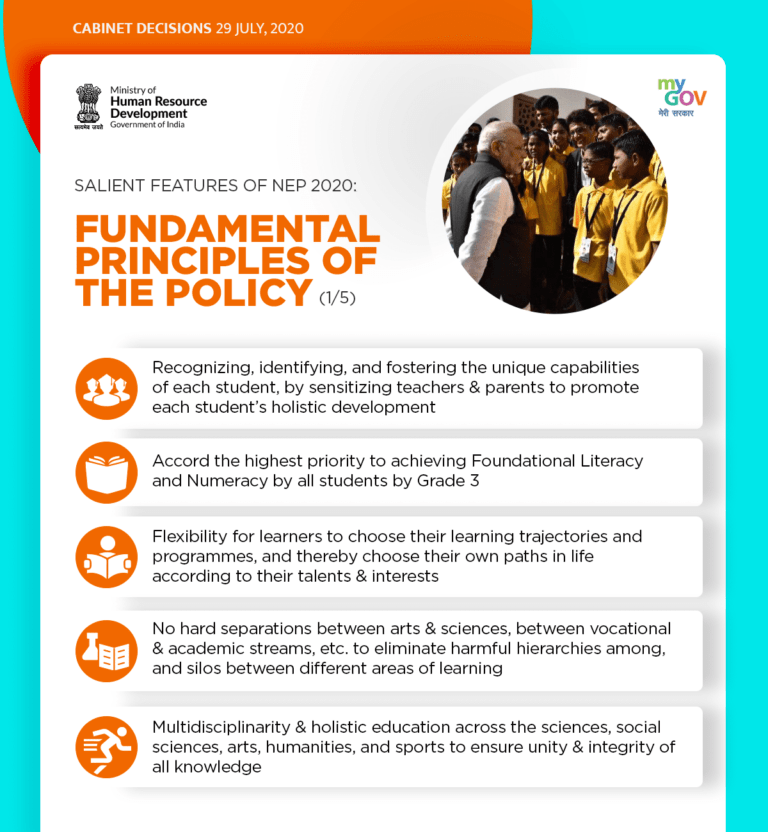Knowledge
Salient Features of NEP-2020
The National Education Policy 2020 proposes various reforms in school education as well as higher education including technical education.
National Education Policy 2020 was announced on 29.07.2020. The National Education Policy 2020 proposes various reforms in school education as well as higher education including technical education. A number of action points/activities for implementation in school education as well as higher education are mentioned in the National Education Policy 2020. Details of the salient features of NEP 2020 are as follows-
- Ensuring Universal Access at All Levels of schooling from pre-primary school to Grade 12;
- Ensuring quality early childhood care and education for all children between 3-6 years;
- New Curricular and Pedagogical Structure (5+3+3+4);
- No hard separations between arts and sciences, between curricular and extra-curricular activities, between vocational and academic streams;
- Establishing National Mission on Foundational Literacy and Numeracy;
- Emphasis on promoting multilingualism and Indian languages; The medium of instruction until at least Grade 5, but preferably till Grade 8 and beyond, will be the home language/mother tongue/local language/regional language.
- Assessment reforms – Board Exams on up to two occasions during any given school year, one main examination and one for improvement, if desired;
- Setting up of a new National Assessment Centre, PARAKH (Performance Assessment, Review, and Analysis of Knowledge for Holistic Development);
- Equitable and inclusive education – Special emphasis is given to Socially and Economically Disadvantaged Groups (SEDGs);
- A separate Gender Inclusion fund and Special Education Zones for disadvantaged regions and groups;
- Robust and transparent processes for recruitment of teachers and merit based performance;
- Ensuring availability of all resources through school complexes and clusters;
(xiii) Setting up of State School Standards Authority (SSSA);
(xiv) Exposure to vocational education in school and higher education system;
- Increasing GER in higher education to 50%;
(xvi) Holistic and Multidisciplinary Education with multiple entry/exit options;
- NTA to offer Common Entrance Exam for Admission to HEIs;
- Establishment of Academic Bank of Credit;
(xix) Setting up of Multidisciplinary Education and Research Universities (MERUs);
- Setting up of National Research Foundation (NRF);
(xxi) ‘Light but Tight’ regulation;
- The single overarching umbrella body for the promotion of the higher education sector including teacher education and excluding medical and legal education- the Higher Education Commission of India (HECI)-with independent bodies for standard setting- the General Education Council; funding-Higher Education Grants Council (HEGC); accreditation- National Accreditation Council (NAC); and regulation- National Higher Education Regulatory Council (NHERC);
- Expansion of open and distance learning to increase Gross Enrolment Ratio (GER).
- Internationalization of Education
- Professional Education will be an integral part of the higher education system. Stand-alone technical universities, health science universities, legal and agricultural universities, or institutions in these or other fields, will aim to become multi-disciplinary institutions.
- Teacher Education – 4-year integrated stage-specific, subject-specific Bachelor of Education
- Establishing a National Mission for Mentoring.
- Creation of an autonomous body, the National Educational Technology Forum (NETF) to provide a platform for the free exchange of ideas on the use of technology to enhance learning, assessment, planning, and administration. Appropriate integration of technology into all levels of education.
- Achieving 100% youth and adult literacy.
- Multiple mechanisms with checks and balances will combat and stop the commercialization of higher education.
- All education institutions will be held to similar standards of audit and disclosure as not-for-profit entities.
- The Centre and the States will work together to increase the public investment in the Education sector to reach 6% of GDP at the earliest.
- Strengthening of the Central Advisory Board of Education to ensure coordination to bring overall focus on quality education.
NEP 2020 aims to increase the GER to 100% in preschool to secondary level by 2030 whereas GER in Higher Education includes vocational education from 26.3% (2018) to 50% by 2035.
The Central Sector Scheme Pandit Madan Mohan Malaviya National Mission on Teachers and Teaching (PMMMNMTT) was launched in 2014 to address comprehensively all issues related to Teacher Training/ Capacity Building and Professional Development of Teachers. Under the components, a total of 95 Centres were established throughout the country through which faculties/Teachers have been trained. Currently, The Standing Finance Committee has appraised the Scheme and recommended it for continuation till 2025-2026 with a total outlay of Rs. 493.68 crores. Under the PMMMNMTT Scheme Centres are established on the basis of the proposals received from education institutions, their screening by the Screening Committee, and approval by the Project Approval Board.
The information was given by the Minister of State for Education, Dr. Subhas Sarkar in a written reply in the Lok Sabha on 1st August 2022.
Here is a set of infographics highlighting the fundamental principles of National Education Policy 2020:
